How To Use Letter Service
For an agency which has considerable volume of debtor letters to be printed a day, where time and
wear & tear on your printers are excessive and your staff can't keep up with folding/envelope
stuffing to get your mailings out in a timely manner, you may be ready to consider outsourcing your
daily debtor letter batches to a professional mail house. The benefit of these service providers
is that they have the industrial equipment to output your thousands of letters daily without delay
and at a cost savings as compared to what you currently spend on supplies, equipment, time and labor.
Letter Service is a functionality that allows you to output to electronic file the "insert" portions
of your letters which are sent to the provider of your choice. You Letter Service provider has set
up your letters in advance and is able to read your data files, outputting hard-copy letters in their
entirety from the variable data field content only data you provide.
Item Check List of what you need to be able to do, or have already taken care of doing, in
advance of utilizing the Letter Service feature are:
- You are able to print a letter to one or more debtors.
- Understand and use Letter Contacts on batches of debtor accounts
- Have contracted with a Letter Service provider and have already provided them with template
output of your letter templates, or are in the process of having your letter templates set
up with said provider. See the end of this document for a few providers of this type of
service.
- You are able to save and retrieve a file from a prescribed path on your workstation or from a
path on a network drive.
- You have you purchased a license for the add-on Letter Service module from Administration at
250-391-0466 option 3.
When you use Letter Service, the transmission of your daily file from your office to your provider
can take place by sending them the file via an email attachment, internet drop-off on a website or
via an online FTP transfer. Our Technical Services team have successfully installed processes which
delivers your daily file by FTP drop-off using a .bat file in a Windows Scheduler. Contact us for
pricing if you would like to explore this convenient automation for your own site.
Setup With Your Provider
Assign a alphanumeric code to each of the letters that you will be using for letter service. Create
a full printout of the letter populated with realistic data so that they can see exactly how each
letter is to look and where all the data insert fields are within each letter form. Find out from
your provider whether they prefer Ontario or Non-Ontario standard format for the data files, as you
have the choice of which type you can output. If they prefer a custom format, Collect! may be able
to support it. Please refer to the help topic
How to Setup Letter Service File Format - Not Ontario Format for more information.
Once your provider has all the letters set up on their end, it is time to create a test file on your
side to submit to them.
 Letter Service output is completely separate and apart from inhouse hard-copy letter
printing. Your company can still print internally and generate any letter you need to either
on a per file basis or batch, when needed.
Letter Service output is completely separate and apart from inhouse hard-copy letter
printing. Your company can still print internally and generate any letter you need to either
on a per file basis or batch, when needed.

Creating A Debtor Letter For Letter Service
Choose the menu path "Print\ Customize Printing\Edit Report Templates".

Print Menu - Edit Reports
This will display a list of all reports in your system print menu.

Report Definition List
Use your arrow keys to navigate to the first letter you plan to use in Letter Service and stop when
your letter name is highlighted. Press your spacebar to highlight this letter name. Click Ctrl+C to
copy, then Ctrl+V to paste. Now you will have two versions of this letter in your print menu. Rename
the new copy you just made by adding "LS" to the end of the Name. You will be making changes to both
the inside of the letter body and the Report Options to change this to a Letter Service style output.
For simple letters (that do not contain complex use of variables, conditional logic or record loops),
your Report Body will end up appearing as only the Printable Field Codes showing that are to be
inserted into your letters. The Letter Service company does not need or want you to have the whole
letter, static content and all, in the text file you will delivery to them daily - just the the
variable data for the individual debtors and the indicators as to which letter number to use on their
end.

Modify Your Letter Report Body
Update the letter code as per the format that you want to use. Please refer to the Help topics
How To Setup Letter Service File Format - Not Ontario Format and
How To Setup Letter Service File Format - Ontario Format for more information.
The original letter may have looked like:
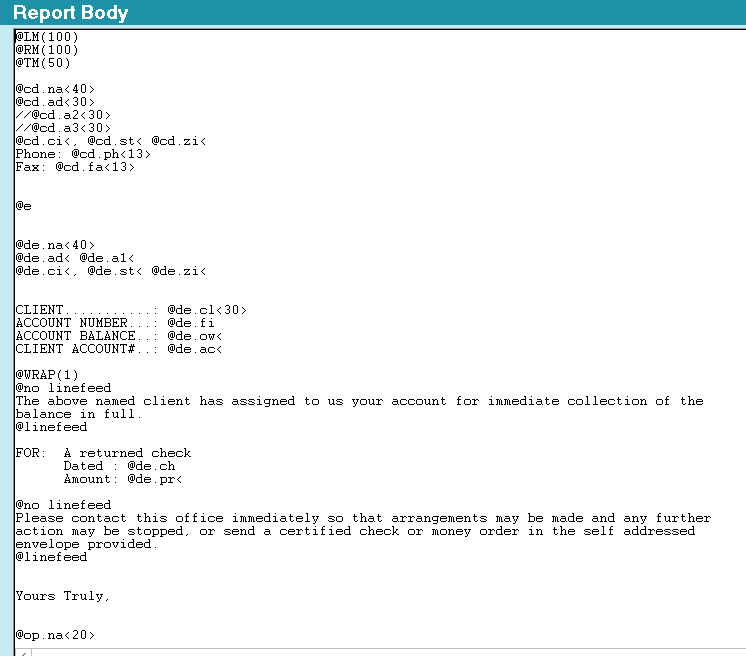
Report Body BEFORE Letter Service Edit
After you have modified the Report Body, may look like:
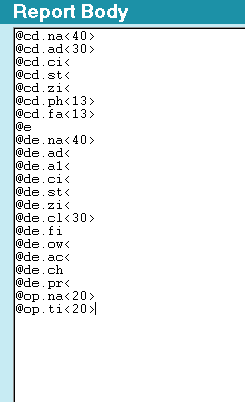
Report Body AFTER Letter Service Edit
Now that you have prepared the inside of the Report Body to output only that which your provider
needs, the next step is to set the Letter Service options. With the Report Definitions screen still
open, click the Options button in the lower left corner of the window.

Report Options Screen

Report Options Form
Click Here to View this Form.
Click Here to Close this Form.
The Report Options form stores settings that apply to a
particular report. This allows you to specify different settings for
individual reports depending on your requirements. You can
choose a destination, a filename, user rights, set the margins
and page height, give your report a number and switch on
NCOA check when using letter service.

Report Options
Additional options are available when you select Other
from the Destination field pick list. For instance, you can create
special reports to print out of MS Word or Word Pad using
mail merge.
 You should use this form to enter any custom settings
that you want to apply to your whole report. At the very least, you
should ensure that Collect!'s default settings are restored, by
entering RESET codes in the Printer Initialization Codes and
Printer Termination Codes fields.
You should use this form to enter any custom settings
that you want to apply to your whole report. At the very least, you
should ensure that Collect!'s default settings are restored, by
entering RESET codes in the Printer Initialization Codes and
Printer Termination Codes fields.
 When importing or exporting reports, settings in the
Report Options are imported or exported as well.
When importing or exporting reports, settings in the
Report Options are imported or exported as well.
Destination
Choose an output device from the pick list. Click the arrow
to display the choices. This setting should be filled in,
especially if you intend to print this report in your daily
batch letters.
Printer - Send the report or letter
directly to a printer.
Screen - Preview and edit your
report on the screen before printing.
File - Send your report to a file
which you can later edit using a word processor, or
import into a spreadsheet or database. You can enter
a filename in the field labeled Filename
or enter a filename when the report is printed.
Spreadsheet - Print quickly and easily to
your spreadsheet program.
Browser - Format the report as an HTML
page and view it in the browser.
Other - Use with CSV files or Tab delimited
reports, or in combination with RTF reports. A filename is
entered in the field labeled Filename.
A field labeled Redirect To becomes
visible with this selection and you can enter a filename
or a web site to redirect your report output to.
Email - Send this letter directly to the
account's Email address. When you select "Email" as
your Destination and additional field becomes visible,
a check box labeled "Use SMS." Please refer to Help
topic, SMS Email Setup for more information.

Sub-Report
If this report is called via another report with @REPORT
or @SUBREPORT, and you do not want the report to be run
directly, you can check this box to hide it from the
Report list when users click the Print button.

File Name
Enter the File Name here if you intend to send the
report to a file. By default, files are placed in the root
folder of your Collect! application. You can specify a
drive and the name of an existing folder, if you wish
to be more specific.
Examples:
To save the file in the Collect folder, enter FILENAME.EXT,
for example, myreport.txt.
To save the file on drive F:\ enter F:\FILENAME.EXT,
for example, F:\myreport.txt.
To save the file in F:\ALLREPORTS
enter F:\ALLREPORTS\FILENAME.EXT,
for example, F:\Allreports\myreport.txt.
In this case, the folder ALLREPORTS must already
exist or you will get an error message.
To use this field with *.rtf or *.csv files, enter the path
and name of the file. For example, LETTER1.RTF to
open the RTF file or MAILMERGE.CSV to print to a
CSV file.
 When you choose 'File' from the
Destination pick list and enter a complete
path in the File Name field, the
Print Output Options dialog will
automatically display this information
when you choose to print the report. You
will see that 'File' will be marked as the
Destination and the path you entered as
the File Name with be displayed in the
Print Output Options 'Path' field.
When you choose 'File' from the
Destination pick list and enter a complete
path in the File Name field, the
Print Output Options dialog will
automatically display this information
when you choose to print the report. You
will see that 'File' will be marked as the
Destination and the path you entered as
the File Name with be displayed in the
Print Output Options 'Path' field.

File Name With Date/Time Stamp
If you enter simply the extension, .csv or .rtf (without
the asterisk!) in the File Name field, Collect! will assign
a file name to the report when you print it. Collect adds
an operator, date, time and increment stamp.
For example, OWN-20080305-115656-1.csv.
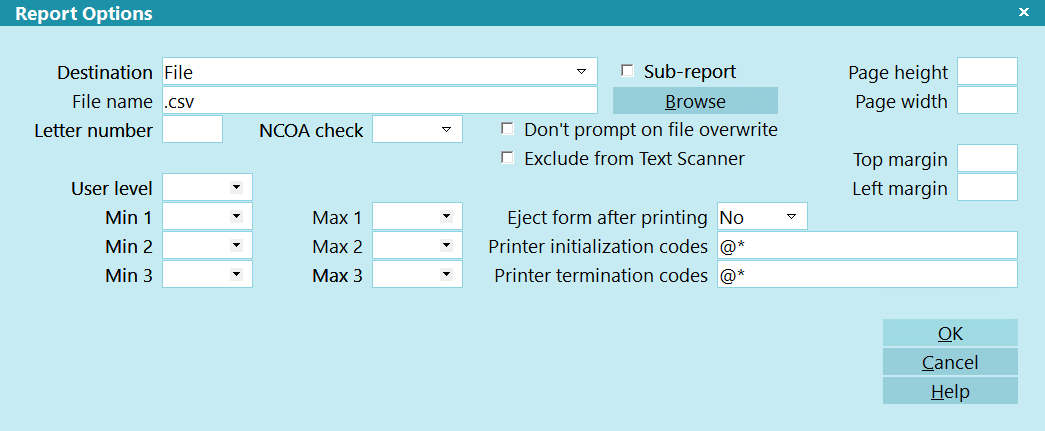
File Name Setting for OpID/Date/Time Stamp
By default, files are stored in the
Collect\bin\global\masterdb\letters folder.
For example,
Collect\bin\global\masterdb\letters\OWN-20080305-115656-1.csv.
You can also enter your own location. For example,
C:\myfolder\.csv will output your files to C:\myfolder.
For example, C:\myfolder\OWN-20080305-115656-1.csv.

File Name With Use SMS
When you have switched ON "Use SMS" with an Email
destination, you can enter an SMS Domain Name in the
File Name field. Please refer to Help topic,
SMS Email Setup for more information.

Browse
Select the BROWSE button to navigate to a folder of
your choice for saving this report to FILE. Enter a name
for your report and a valid extension, such as CSV or TXT.
Collect! will display the path. When the report is printed,
it will be saved to the folder you selected.
 By default, reports are saved to your letters folder
so you do not have to select a folder here. This
is just a convenience for users who need more
flexibility for storing report files.
By default, reports are saved to your letters folder
so you do not have to select a folder here. This
is just a convenience for users who need more
flexibility for storing report files.

Letter Number
This is used to identify letter templates being
sent to a letter service provider. The number you
select in this field will match the setup letter
number your provider has created to match that specific
letter. Each letter you plan on sending to the mailing
house needs to have a unique value. This number is
printed in the debtor's information sent to the Letter
Service and is used by them to print each letter
correctly. Generally, samples of the report and report
body codes must be sent to your service provider of choice
as part of your setup process with them.
This field support alphanumeric characters.
 When you print your letter batch to a
service bureau, the system will only
output to text file those letters that
have a letter number.
When you print your letter batch to a
service bureau, the system will only
output to text file those letters that
have a letter number.

NCOA Check
This switch is used for Letter Service. When it is
switched ON with a check mark, a special code is
included in the Letter Service output file. This tells
the Letter Service to perform a National Change
of Address check on this Debtor.
 When printing your Letter Service batch,
switch ON 'Print to unverified addresses'
in Batch Letter Options to force Collect!
to print to all debtors in the batch, even
those with "bad" addresses, which means
the 'Address OK' switch is OFF in the
Debtor form.
When printing your Letter Service batch,
switch ON 'Print to unverified addresses'
in Batch Letter Options to force Collect!
to print to all debtors in the batch, even
those with "bad" addresses, which means
the 'Address OK' switch is OFF in the
Debtor form.
Please refer to How To Use Letter Service for
more details.

Don't Prompt On File Overwrite
Switch this ON with a check mark to stop Collect! from
showing you a prompt if you are printing to file and the
file already exists. When this switch is ON, Collect!
will automatically overwrite the existing file that has
the same name as the file you are printing.

Exclude From Text Scanner
Switch this ON with a check mark to exclude this report
or letter from the Text Scanner.
The Text Scanner is a utility under the Customize Printing
menu that allows you to tag Report Definitions, then search
for a string of text. All reports and letters that do not
contain the text will be tagged.

Save To Letters Folder
This box applies to scenarios where files would be saved to
either the Debtor or Client attachment folders.
Switch this ON with a check mark to force any files created
by this report to always save in the Letters folder located
at Collect\bin\global\{dbname}\letters.

User Level
This can be used to limit the Users allowed to print
certain reports. You pick from the list of User levels
and choose one. Anyone with that level or better will
be able to print that letter or report.
For example, if you enter a 10 here, only Users at
level 10 can print this report. If you enter a 20 here,
all Users at levels 10 and 20 are allowed to print the
report. Enter a 60 here, and all Users from levels 10
to level 60 are allowed to print the report.
 What actually happens is that when the
User picks the Print command, only
those reports that they are allowed to
print appear in the list of available reports.
Thus, the User is never aware of the
reports they don't have access to.
What actually happens is that when the
User picks the Print command, only
those reports that they are allowed to
print appear in the list of available reports.
Thus, the User is never aware of the
reports they don't have access to.

Min 1
The MIN and MAX fields allow you to set up to 3
ranges of Users per report. A User level that falls
within any of the selected ranges will have access
to the report. Otherwise, they won't be able to run
the report.
Press F2 while on the MIN or MAX field to display a
pick list of User Levels that you can select from.
Example:
Min 1 -- 10 Max 1 -- 20 This range encompasses
all user levels between 10 and 20. They can run
the report.

Max 1
The MIN and MAX fields allow you to set up to 3
ranges of Users per report. A User level that falls
within any of the selected ranges will have access
to the report. Otherwise, they won't be able to run
the report.
Press F2 while on the MIN or MAX field to display a
pick list of User Levels that you can select from.
Example:
Min 1 -- 10 Max 1 -- 20 This range encompasses
all user levels between 10 and 20. They can run
the report.

Min 2
The MIN and MAX fields allow you to set up to 3
ranges of Users per report. A User level that falls
within any of the selected ranges will have access
to the report. Otherwise, they won't be able to run
the report.
Press F2 while on the MIN or MAX field to display a
pick list of User Levels that you can select from.
Example:
Min 2 -- 60 Max 2 -- 80 This range encompasses
all user levels between 60 and 80. They can run
the report.

Max 2
The MIN and MAX fields allow you to set up to 3
ranges of Users per report. A User level that falls
within any of the selected ranges will have access
to the report. Otherwise, they won't be able to run
the report.
Press F2 while on the MIN or MAX field to display a
pick list of User Levels that you can select from.
Example:
Min 2 -- 60 Max 2 -- 80 This range encompasses
all user levels between 60 and 80. They can run
the report.

Min 3
The MIN and MAX fields allow you to set up to 3
ranges of Users per report. A User level that falls
within any of the selected ranges will have access
to the report. Otherwise, they won't be able to run
the report.
Press F2 while on the MIN or MAX field to display
a pick list of User Levels that you can select from.
Example:
Min 3 -- 90 Max 3 -- 95 This range encompasses
all user levels between 90 and 95. They can run
the report.

Max 3
The MIN and MAX fields allow you to set up to 3
ranges of Users per report. A User level that falls
within any of the selected ranges will have access
to the report. Otherwise, they won't be able to run
the report.
Press F2 while on the MIN or MAX field to display
a pick list of User Levels that you can select from.
Example:
Min 3 -- 90 Max 3 -- 95 This range encompasses
all user levels between 90 and 95. They can run
the report.
RANGES
Using each Min/Max value, we have set three
separate ranges for the report.
Min 1 -- 10 Max 1 -- 20 All users with user levels from 10 to 20
Min 2 -- 60 Max 2 -- 80 All users with user levels from 60 to 80
Min 3 -- 90 Max 3 -- 95 All users with user levels from 90 to 95
So any operators with a user level between 10
and 20, 60 and 80, and 90 to 95 can run this report.
Operators who do not fall within these ranges will
not even see the report when they view the list
of reports.

Page Height
This field is normally not needed. If you are using
Print via Device Context, your printer will automatically
handle the page height. This field does come into
play when you are printing to Printer Stream, or
controlling the number of lines to force the printer
to print headers and footers for more demanding
report layouts.
This field specifies the number of lines that can be
printed on a page. Typically, this is 66 lines for
dot matrix printers and 60 lines for laser printers.
If your report uses small fonts, you can set the page
height to 88, or to whatever works for the paper size
you are printing on.

Page Width
This field is normally not needed. If you are using
Print via Device Context, your printer will automatically
handle the page width. This field does come into play
when you are printing to Printer Stream, or controlling
the width manually to force the printer to print a
particularly demanding format or layout.
This specifies the number of columns that will fit on
the page. If you are printing and you find that lines
are being chopped off on the right edge, try increasing
the page width.
Normally the width is 80 characters for standard
Courier font 10 cpi and 132 characters for a
standard Courier compressed font.

Top Margin
This tells the printer the number of lines to be left
blank at the top of each page. It is an easy way to
print to paper you already have letterhead printed on.
If you leave this blank, you can leave the right
number of empty lines in the report body itself to
adjust the text down below the pre-printed letter
head paper.
 Margin settings can also be controlled
by using graphic commands. See
How To Position Text And Graphics
for details.
Margin settings can also be controlled
by using graphic commands. See
How To Position Text And Graphics
for details.
 When printing to the screen, the top
margin is ignored. After you review or
edit the letter, you can print with the
F5 key and you can then specify a top
margin before printing.
When printing to the screen, the top
margin is ignored. After you review or
edit the letter, you can print with the
F5 key and you can then specify a top
margin before printing.

Left Margin
This field specifies the number of columns on the
left of the page to skip before printing each line. If
you have a left margin that applies to the complete
report, this is an easy way to control the left margin.
Examples:
Specify 5 for a margin of 1/2 inch.
Specify 10 for a margin of 1 inch.
Specify 15 for a margin of 1 1/2 inches
If you wish to have different left margins set in
different sections of the report, then leave this field
blank and control your left margins within the
report with the @LM command in the report body.
 Margin settings can also be controlled
by using graphic commands. See
How To Position Text And Graphics
for details.
Margin settings can also be controlled
by using graphic commands. See
How To Position Text And Graphics
for details.
 When printing to the screen, the left
margin is ignored. After you review or
edit the letter, you can print with the
F5 key and you can then specify a left
margin before printing.
When printing to the screen, the left
margin is ignored. After you review or
edit the letter, you can print with the
F5 key and you can then specify a left
margin before printing.
You should not try not to use the Left Margin
and @LM commands in the same report. Left
Margin uses characters and depends on the size
of the font. The @LM command uses 100ths
of an inch. Combining these two can produce
erratic results.

Eject Form After Printing
This function causes the printer to feed a new page
into the printer after printing a report. Normally,
this should always be set to NO.
 Use the @f command at the bottom of your
Report Body if you want to feed a new
page after printing your report.
Use the @f command at the bottom of your
Report Body if you want to feed a new
page after printing your report.

Printer Initialization Codes
This command allows you to set up
printer control codes to be executed before the
report or letter is printed. This includes page
orientation and custom fonts. Also, you can ensure
that certain default settings are being used for
this report. Using Initializing codes will also help
the printer to swap its internal code pages, if you
need to print letters that are of different languages.
One letter French, the next Spanish, and then back
to English for example.
 When different reports are printed at the
same time, formatting from one report
can carry over to another, with
undesirable effects. To ensure that this
does not happen, enter appropriate
codes here.
When different reports are printed at the
same time, formatting from one report
can carry over to another, with
undesirable effects. To ensure that this
does not happen, enter appropriate
codes here.
For instance, if you want to set the printer command
codes back to their default values, set the print
orientation to portrait, and set the print font to A.
To do this, enter the following command line:
@*PA
The * will force a reset of the printer, the P will set
the page orientation to Portrait, the A will set
the printer font to Courier 10 cpi.
Another example sets the page orientation to
landscape and uses a smaller font.
@*LF
The * will force a reset of the printer, the L will set
the page orientation to Landscape, the F will set the
printer font to Courier 16.66 cpi or compressed font.

Printer Termination Codes
Enter the printer control codes to be executed after
the report or letter has been printed. Codes entered
in the Printer Initialization Codes field must be "turned
off" in the Printer Termination Codes fields. Otherwise,
the report's formatting may carry into the next letter or
report that you print.
 When different reports are printed at the
same time, formatting from one report
can carry over to another, with
undesirable effects. To ensure that this does
not happen, enter appropriate codes here.
When different reports are printed at the
same time, formatting from one report
can carry over to another, with
undesirable effects. To ensure that this does
not happen, enter appropriate codes here.
If you want to reset the printer control codes back
to their default values, reverse the order of the codes
entered in the Printer Initialization Codes field to
"turn off" each setting.
For example, using the sample codes shown above,
in Printer Initialization Codes, we will enter the
appropriate termination codes for each case.
@AP* turns off @*PA
@FL* turns off @*LF
Please refer to Printer Control Code for information
on codes that can be used.
 Using Termination codes will also help
the printer to swap its internal code pages
if you need to print letters that are of
different languages. One letter French,
the next Spanish and then back to
English for example.
Using Termination codes will also help
the printer to swap its internal code pages
if you need to print letters that are of
different languages. One letter French,
the next Spanish and then back to
English for example.

Redirect To
This field is visible only when you select Other in
the Destination field.
Use this field to enter a document that you want
your report to print to. For instance, you can use this
for merging data from Collect! into a label template
created in MS Word. Enter the name of the template
here. Place both the template and the file to merge
in the same folder.
Send the report to a CSV file and use the Redirect To
field to specify an MS Word template DOC to open
with merged data from Collect!. Place both the template
and the file to merge in the same folder.
 You can use a relative path here, for
example, ".\styles\mailmerge.csv" (that is a
dot and a slash and then the folder name
and filename.)
You can use a relative path here, for
example, ".\styles\mailmerge.csv" (that is a
dot and a slash and then the folder name
and filename.)
This field can hold the name of a file to print to when
you are producing a tab delimited report.

Report Options with Other Destination and Redirect To
 If you put a URL in this field, Collect! will use
your web browser to go to the web site when
you print the report.
If you put a URL in this field, Collect! will use
your web browser to go to the web site when
you print the report.

Use SMS
This check box is visible only when you have selected "Email"
as the Destination for your report. When you switch it ON with
a check mark, you can type an SMS Domain Name into the
File Name field. If you leave the File Name field blank, Collect!
will use the Default Domain Name set in the SMS Email
Setup form. Please refer to Help topic, SMS Email Setup for
more information.

Legacy Report
In version 14, we are normalizing the Report Writer syntax. As part of that process, some poor coding
habits cause reports to no longer work. Check this option to invoke "Legacy" behavior. This box also
applies to reports called via the Collect! REST API.

Include In Client Portal
Check this box to include the report or letter in the Client Portal. Reports in the Client Portal
must be Started on either Client or Debtor.
 WARNING: Any report that has this box enabled will be visible to Clients. Please ensure that the
Report Body is coded appropriately for security.
WARNING: Any report that has this box enabled will be visible to Clients. Please ensure that the
Report Body is coded appropriately for security.

Help
Select this for help on the Report Options form
and links to related topics on creating and printing
reports and letters.

Cancel
Select this button to ignore any changes you may
have made and then return to the previous form.

OK
Selecting this button will save any data you have
entered and return you to the previous form.

Destination
Set this field to "File".
File Name
Leave this blank. When you create a letter service batch output every day, you will define the
filename when prompted to do so during the creation of the output text file you will send to your
provider.
Letter Number
Enter the template ID in the Letter Number field supplied by the letter vendor.
NCOA Check
This switch can be checked On if you have enabled this address checking service with your letter
service provider. This switch checked ON alerts your provider to do an address check on any account
that you have flagged as Address Not OK. That means the check box labeled
Address OK on the main debtor screen is switched OFF, indicating that the address
is either not verified or return mail was received previously. Each site has their own interpretation
of this switch being Off or On. The Letter Service module construes the Address OK switch being Off
as qualifying for an NCOA check.

Test Your Letter
This letter must now be set up a Letter contact on some test accounts in order to create a test file
for your Letter Service provider. Make sure to send them a pdf test templates containing ALL of the
letters you will be sending them during the course of normal operations. They need to set up each
letter format separately in THEIR system, just like you had to set up the letters in your system.
Navigate to a test debtor and click into the Contacts Tab. Click New to create a new Contact. Choose
the Type to be Letter, then click the drop-down arrow at the far right of the Description field, then
navigate to the Letter Service Letter template and select it. Set the Due Date as today.
After you have set up a Letter contact for all of Letter Service templates that you are testing, you
are ready to create a test output text file.

Running Letter Service On Scheduled Letters
To generate the data file to send to your service provider:
- Select the menu path "Print\Daily Reports\Letter Service Bureau".

Print - Daily Reports - Letter Service Bureau
- You will get a Batch Letter Options popup that looks exactly the same as the one you normally
get to print hard-copy letters in-house.
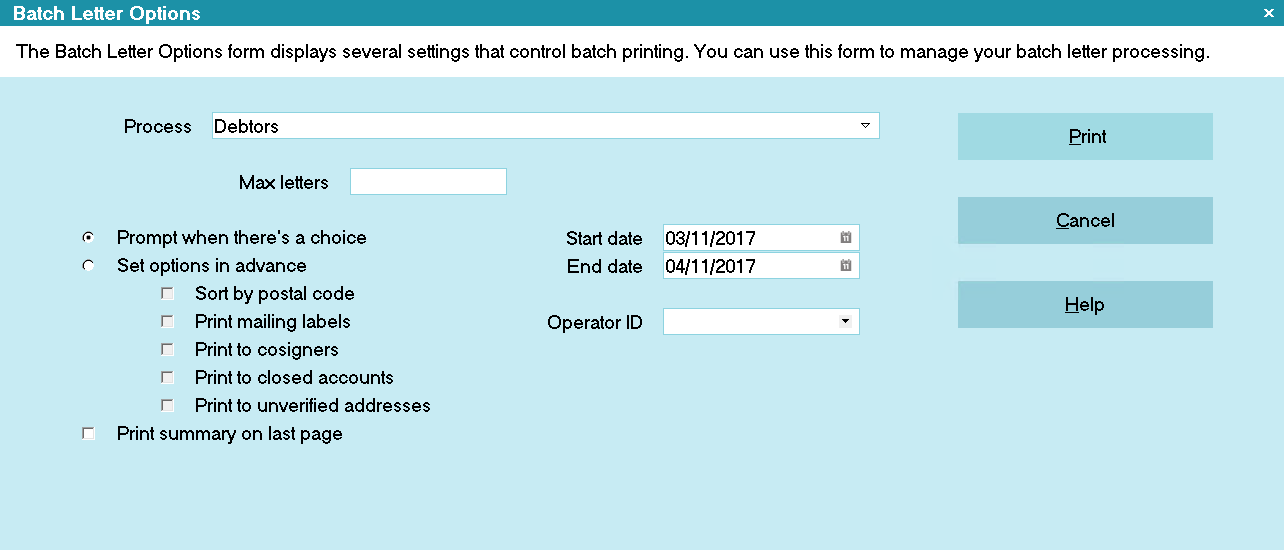
Batch Letter Options
Like with hard-copy printed batches, you have the same areas of control where you can opt to increase
or decrease the default date range or modify any of the settings on the screen.
 If you select Set options in advance, you can eliminate prompts for Address
Not OK, Cosigners and Closed accounts. This frees you up from having to monitor the batch
process and be available to answer the prompts on a per file basis because you've already
decisioned this for the whole batch. There will be no prompts to answer questions if you set
this switch.
If you select Set options in advance, you can eliminate prompts for Address
Not OK, Cosigners and Closed accounts. This frees you up from having to monitor the batch
process and be available to answer the prompts on a per file basis because you've already
decisioned this for the whole batch. There will be no prompts to answer questions if you set
this switch.
- When you are ready, click the PRINT button on the Batch Letter Options screen to continue. The
process knows it is writing out to a file, it is not really going to print anything. Most
importantly, it does NOT cause any of your non-letter service letters to be launched. Only the
templates you have indicated with a value in the Letter Number field on the Report Options
screen will be processed.
When the next window pops up, you will see that it is called "Letter Service" and that it has the
"Letter service" output indicated as well as "Save to file only" radio buttons activated.
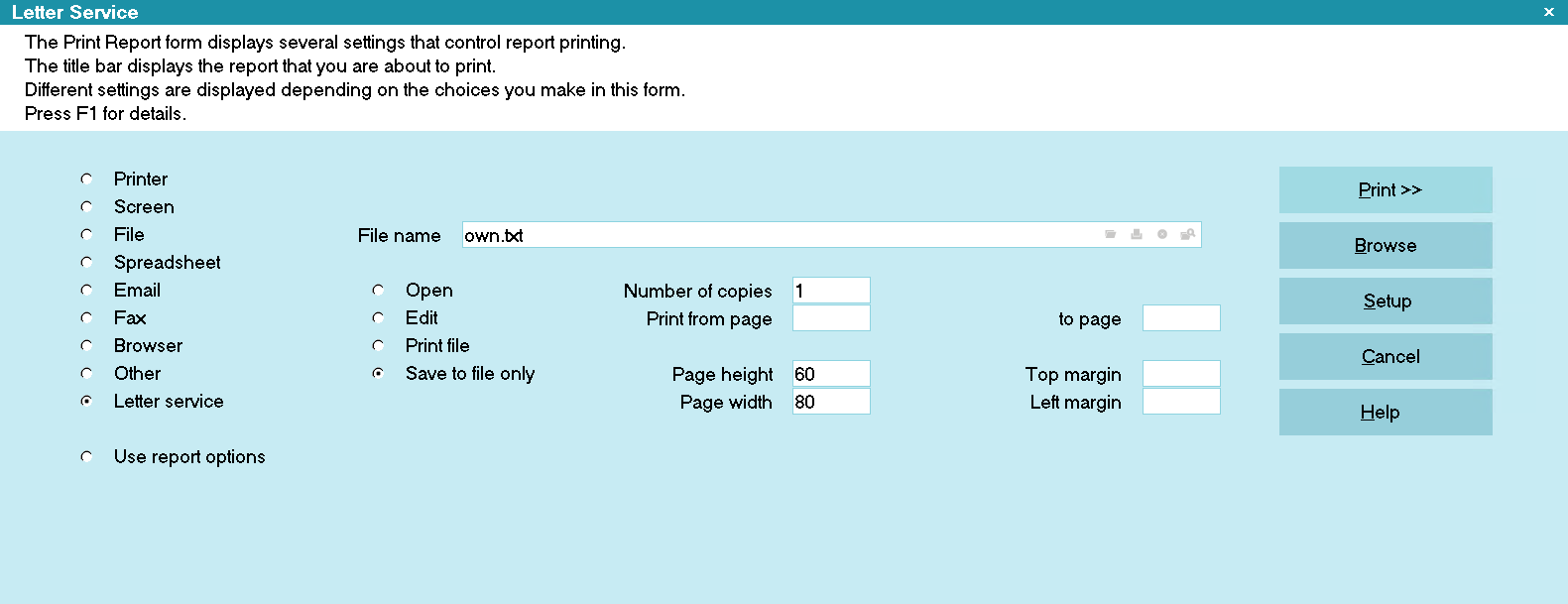
Report Output Options
By default, the output file will be saved in Collect\bin\global\masterdb\letters. You can change the
path and/or the name of the file that is output as you wish. If your letter service vendor requested
a file extension, then ensure to use that; otherwise, use ".txt" as the extension.
- Select the PRINT button to output your letter service file.

NCOA Check Through Letter Service
The NCOA check (National Change Of Address) is an option that your letter service provider may
provide, but there is an additional fee for each address they attempt to verify.
As mentioned, the NCOA check is enabled through the Report Options screen on a per Letter format basis.
When NCOA check is enabled for a letter, the process will output an NCOA code for every debtor or
cosigner letter printed to an unverified address - meaning the "Address OK" switch on the debtor
screen is NOT checked. Depending on your internal processes, this switch being unchecked can be a
function of return mail previously and/or a known bad address OR it could be unchecked in the absence
of a formal verification that the address is good. The code output with the letter service file
triggers your letter service provider to check that address and return NCOA information to you.
If you did not enable NCOA check and your process includes debtors with Address OK switches unchecked,
you will be prompted as below, if you had clicked 'Prompt when there is a choice' in Batch Letter Options.

Bad Address Prompt
If you select YES, this debtor's information will be included in the letter service file, but
without the NCOA code.
If you select NO, the debtor will be ignored and not output to the file.
If you select ALL, all unverified addresses - meaning any addresses in your system that have the
Address OK switch unchecked on debtor or cosigner screens - they will be printed with no further
prompts.
 You may choose to set options in advance and select Print to unverified
addresses in Batch Letter Options to output all unchecked Address OK accounts with
no further prompts.
You may choose to set options in advance and select Print to unverified
addresses in Batch Letter Options to output all unchecked Address OK accounts with
no further prompts.
#K#03 Segment
The #K#03 segment is an addition to the letter service module to match new file format standards
required by letter service providers. This switch is enabled via the menu path
"System\Preferences\Reports and Printing\Printer and Report Setup\Insert #K#03 segment".
 This is the same setup screen where you indicate whether you are outputting to your
letter service provider in Ontario or Non-Ontario letter service output format.
This is the same setup screen where you indicate whether you are outputting to your
letter service provider in Ontario or Non-Ontario letter service output format.
A letter sent to letter service with NCOA enabled will print letters to debtors with bad addresses
preceded by the #K#02 segment. This tells the letter service that this debtor has a bad address. It
also attaches a "D" for Debtor and "C" for Cosigner to the File Number.
Example: ^D1400^ for Debtor, or ^C1400^ for Cosigner.
 The Dfilenumber and Cfilenumber are used by Collect!'s Import NCOA feature to update records
returned from NCOA.
The Dfilenumber and Cfilenumber are used by Collect!'s Import NCOA feature to update records
returned from NCOA.
All other debtor letters print normally, with no special formatting. With the #K#03 Segment switch
ON, debtors with bad addresses will still receive the #K#02 segment, but in addition, debtors with
good addresses will now be preceded by the #K#03 segment. This means that even good addresses will
have the Dfilenumber or the Cfilenumber, as described above. That way, you can also update good
addresses when NCOA returns data.
 When you use the Import NCOA option to update records after an NCOA check, Collect! expects
to find the Debtor and Cosigner identifiers. These will be correct only if you have switched
ON NCOA as described above. If you wish to check "OK" addresses as well, you need to have
the #K#03 preference set to insert the segment.
When you use the Import NCOA option to update records after an NCOA check, Collect! expects
to find the Debtor and Cosigner identifiers. These will be correct only if you have switched
ON NCOA as described above. If you wish to check "OK" addresses as well, you need to have
the #K#03 preference set to insert the segment.

Sending To Cosigners
If you chose 'Prompt when there is a choice' in the Batch Letter Options screen, you will also
receive a prompt asking you if you would like to send the letter to the cosigners, if your debtors
have cosigners.

Print To Cosigners Prompt
 Select "Set options in advance" to decision all the questions needed to be answered pre-batch
and negate being prompted on a per file basis throughout the batch.
Select "Set options in advance" to decision all the questions needed to be answered pre-batch
and negate being prompted on a per file basis throughout the batch.
The Cosigner Tab can contain many kinds of "other" parties, inclusive of those that are not
responsible on the debt. You can restrict printing to records with the "Class" set to "Cosigner" by
checking the switch in the menu path "System\Preferences\Reports and Printing\Printer and Report Setup",
and check the "Restrict to cosigners only". Refer to the Help Topic, Report and Printer Setups for
more details.

Additional Prompts
You may receive additional popup questions or warnings depending on situations that Collect!
encounters. Answer YES or NO, according to your requirements.

Mark Batch AS Completed
This screen will ask whether you would like this letter batch marked as completed. If you select YES,
this batch of letters will be marked as Completed and it will be removed from the pending queue.
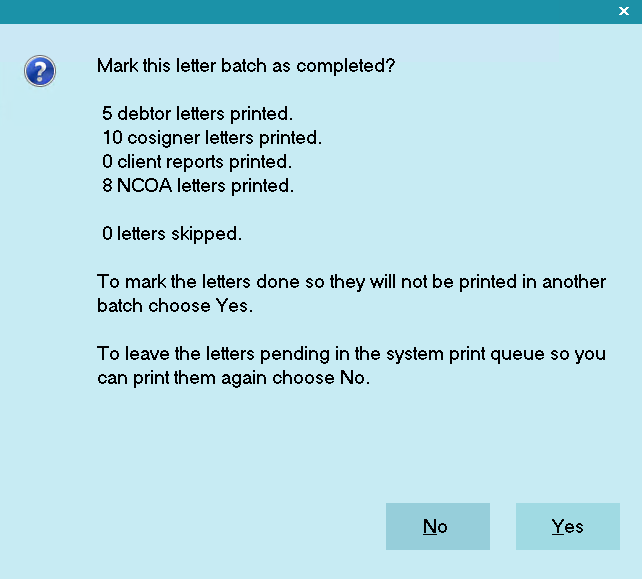
Prompt To Mark Contacts Done
You will receive a popup message acknowledging how many letters were processed to the file.

You will also be given the option of printing a summary report. You do not need to do this unless
your site requires logging of successful batch completions. If you do opt to receive this, the
file will be saved to the Collect\Log Files folder with a date/time stamp.

Print Summary Report To WIP List

Address Not OK
If a Debtor or Cosigner was skipped because of a bad address, the Letter contact is not marked
Completed, but is instead left "In Progress" with an indicator written to the contact's Attachment
field. It will say 0 indicates that the Debtor was skipped, OR 1
indicates that the Cosigner was skipped. If the Address OK switch is checked back ON at a future
date, then this contact will be processed the next time you print your Letter Service file from the
date that the address was put back in OK standing. Using the indicator as a safeguard, Collect!
will not print the same letter twice to the same Debtor or Cosigner.
 You can also view the Application Log via the menu path \System\Diagnostics to determine
which Debtors and Cosigners were skipped when the batch was processed.
You can also view the Application Log via the menu path \System\Diagnostics to determine
which Debtors and Cosigners were skipped when the batch was processed.

Letter Service File
If you would like to confirm that the letters that you wanted sent out to your mailing house provider
were output to the file, open your output file in Notepad (or the pure text editor of your choice)
and review it. You will need to navigate the path to where you saved the file, right click on it
and use the option to "Open with" in your windows File Explorer, and open it with Notepad.
 WARNING: Do NOT open these text files in a word processor application like Word or Wordpad. The
control codes inserted and/or modification of file extensions will change the nature of
the data file, which will render it unreadable by your letter service provider.
WARNING: Do NOT open these text files in a word processor application like Word or Wordpad. The
control codes inserted and/or modification of file extensions will change the nature of
the data file, which will render it unreadable by your letter service provider.
The contents of your file should look something like the following:
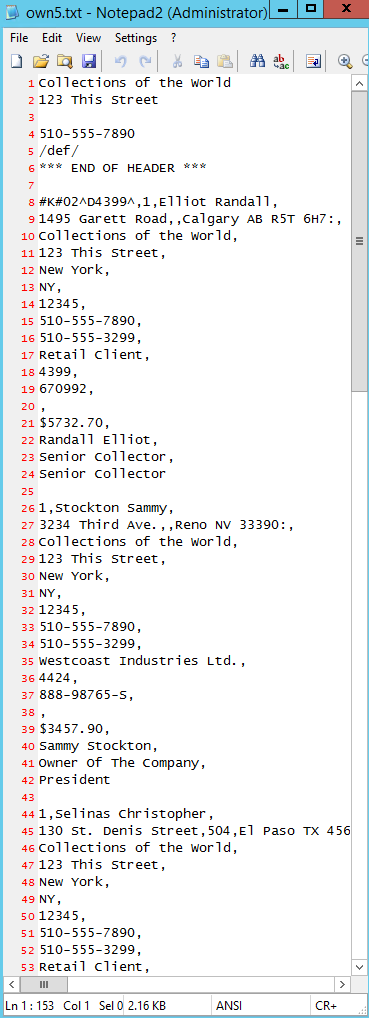
Letter Service File Contents
If you have enabled the switch 'Insert #K#03 segment' in the Report And Printer Setup, your file
would look slightly different.
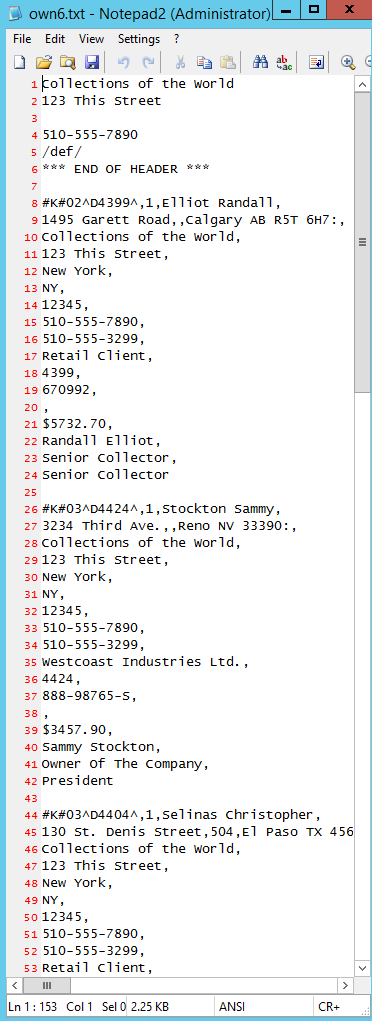
Letter Service File With #K#03 Segment
In this case, the NCOA code will be #K#03 for each account that does not have a #K#02 segment.

Sending Your File To Letter Service
Now you should be ready to send your data to your Letter Service provider by the method agreed upon
between yourselves and your provider.
For information about outsourcing your printing to a professional letter service provider, check
your local listings or Internet searches. To assist you, we have listed a few such established
companies who service this market here:
https://www.collect.org/partners/

| 
Was this page helpful? Do you have any comments on this document? Can we make it better? If so how may we improve this page.
Please click this link to send us your comments: helpinfo@collect.org